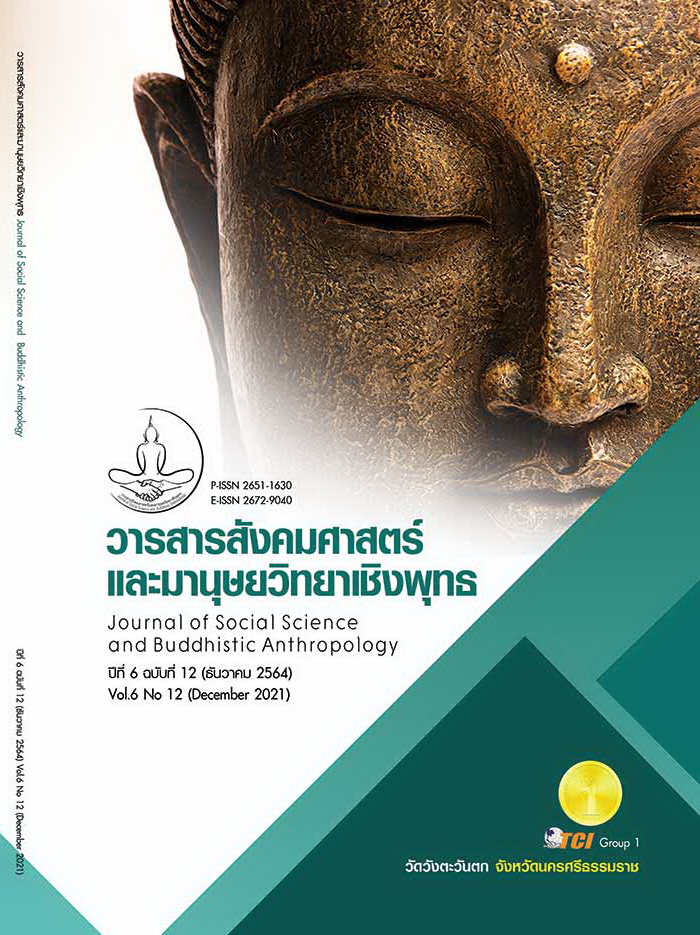MONASTIC LEADERSHIP A CASESTUDY: PHRA PROVOST SOPHONKUNATORN (SOMPONG THONGCHUAY) AND SOME MONKS WITH THE CREATION OF BUDDHIST WORKS TO BE STABLE PERMANENT AND SUSTAINABLE
Keywords:
Mosticna Leadership, Phrakru Sophonkunathon, Buddhism CreationsAbstract
The objectives of this research article were to 1) Study of Sangha Leadership and the process of developing the Buddhist workload 2) Study and analyze creative work, academic work, sculpture, management style, and 3) Get a model for developing the Buddhist workload for stability and sustainability. It is qualitative research that focuses on descriptive analysis and linking information, opinions, and the condition of Sangha leadership to development. Group of informants such as students, Sittiwiharik, Buddhists, 35 person the tool used was a structured interview form. Present the results of research using an inductive method (Analytic Induction) by bringing the data to be organized and classified in a systematic way. It is then used to interpret, relate, and draw conclusions from the information gathered. The results of the research showed that 1) Sangha leadership and the process of developing the Buddhist workload Identify the ability of a leader to lead an organization to lead people to its goals. Both the vision and the work process are consistent in concrete, resulting in successful development work. The Buddhist method was used to manage the faith in order to sustain Buddhism. 2) Analyze creative work, academic work, sculpture, management style Buddhism in management through the development of academic work on Buddhism provide education according to the system of the Thai Sangha There is a sculpture that stands out. Phra Borommathat Thaksin Chedi Sri Sophon and 3) obtaining a model for developing a stable Buddhist workload with a decentralized management model Giving equal opportunity and importance to everyone Psychologically, meditation and Buddhist prayers are used regularly throughout the year. With outstanding leadership practices and socially accepted developments, it has received various awards manifest.
References
เขียน อุไรรัตน์. (15 กันยายน 2562). ก่อนจะมาเป็นวัดคลองเปล. (วนิดา เหมือนจันทร์, ผู้สัมภาษณ์)
คชเสนี สัตยารักษ์. (2560). พระราชดำรัส สมเด็จพระนางเจ้าฯ พระบรมราชินีนาถ ในรัชกาลที่ 9. เรียกใช้เมื่อ 15 พฤษภาคม 2563 จาก https://www.youtube.com › watch
ตราสารมูลนิธิพระครูโสภณคุณาทร (สมปอง ทองชูช่วย). (2559). ข้อบังคับ หมวดที่ 2 วัตถุประสงค์ของมูลนิธิ. หน้า 3 (8 สิงหาคม 2564).
พระครูปลัดสุวัฒนสิทธิคุณ (จิมก่าย). (2563). การศึกษาวิเคราะห์ภาวะผู้นำ: กรณีศึกษา สมเด็จพระพุฒาจารย์ (เกี่ยว อุปเสโณ) ในการบริหารกิจการคณะสงฆ์ไทย. วารสารมหาจุฬานาครทรรศน์, 7(4), 201-218.
พระครูสังฆรักษ์ผาด ฐิติโก. (24 กุมภาพันธ์ 2563). วิเคราะห์งานสร้างคน. (ประสิทธิ์ รักนุ้ย, ผู้สัมภาษณ์)
พระครูโสภณคุณาทร (สมปอง ทองชูช่วย). (2550). มโนปณิธานโครงการบันได 3 ขั้น. ใน บันทึกประวัติพระบรมธาตุทักษิณเจดีย์ศรีโสภณ (หน้า 10-11). จังหวัดสงขลา: อ้อมเอกสาร.
พระปลัดณัฐวุฒิ อานันฺโท และคณะ. (2563). รูปแบบการจัดการวัดให้เป็นศูนย์กลางการศึกษาของชุมชนในประเทศไทย. เรียกใช้เมื่อ 20 ตุลาคม 2564 จาก https://so03.tci-thaijo.org › article › download
พระสมบัติ สุขทวีเลิศพงศ์ และคณะ. (2561). ประสิทธิผลของการบริหารกิจการคณะสงฆ์. เรียกใช้เมื่อ 8 สิงหาคม 2564 จาก https://www.tci-thaijo.org › article › download
วัดราชประดิษฐานหรือวัดพะโคะ. (2564). ฐานข้อมูลท้องถิ่นภาคใต้ มหาวิทยาลัยสงขลานครินทร์. เรียกใช้เมื่อ 5 สิงหาคม 2564 จาก https://clib.psu.c.th>content
สำนักงานราชบัณฑิตยสภา. (2542). บัว 4 เหล่า บุคคล 4 จำพวก. เรียกใช้เมื่อ 16 ตุลาคม 2564 จาก http://legacy.orst.go.th/?knowledges
Downloads
Published
How to Cite
Issue
Section
License
Copyright (c) 2021 Journal of Social Science and Buddhistic Anthropology

This work is licensed under a Creative Commons Attribution-NonCommercial-NoDerivatives 4.0 International License.








